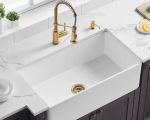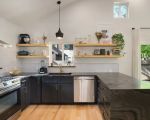How to Remodel a Kitchen with a Mediterranean Style
If you’ve ever walked into a Mediterranean-inspired kitchen, you know that it immediately evokes a sense of warmth, charm, and timeless elegance. The Mediterranean style, with its rich history and vibrant colors, can make any kitchen feel like a vacation retreat. I’ve always dreamed of having this kind of atmosphere in my own home, and after some research and inspiration, I’m excited to share the steps I took to remodel my kitchen with a Mediterranean touch. In this article, I’ll guide you through the process of remodeling your kitchen to embrace Mediterranean style, from the colors to the materials and the small details that will make all the difference. Let’s dive in!
1. Start with the Color Palette
One of the first things I learned when remodeling my kitchen in the Mediterranean style was the importance of the right color palette. Mediterranean kitchens typically feature earthy tones inspired by the landscape of Southern Europe—think sun-kissed yellows, terracotta oranges, and warm neutrals like beige and cream. Blue is also a key color, often used to evoke the Mediterranean sea, along with greens that remind you of olive trees.
1.1 Neutral Backgrounds
I started with neutral tones for the walls and cabinetry, as these serve as a calm backdrop for the more vibrant accents that will follow. Light creams, beiges, and soft whites work wonderfully to reflect natural light, making the kitchen feel brighter and more spacious. These neutrals provide a timeless foundation for your Mediterranean-inspired kitchen.
1.2 Accent Colors
Next, I focused on introducing vibrant accents in the form of blues, greens, and terracotta. The backsplash tiles are a great place to bring in these colors. I opted for hand-painted tiles in a mix of blues, which gave the space a splash of Mediterranean charm while maintaining the airy feel I wanted.
2. Choosing the Right Materials
Materials play a crucial role in creating an authentic Mediterranean kitchen. From natural stone to rustic wood, the materials you choose will set the tone for your space. Mediterranean kitchens often feature materials that have a connection to nature and history, with finishes that feel earthy and grounded.
2.1 Natural Stone and Tile
For the countertops, I opted for classic granite or marble, both of which are frequently used in Mediterranean kitchens. Their durability and timeless look were exactly what I needed to complement the style. I chose a light-colored marble with subtle veining for a sophisticated touch, and it also added a sense of luxury to the kitchen.
2.2 Warm Wood Accents
Wood is another essential material in Mediterranean kitchens. I added rustic wood beams along the ceiling, which not only contributed to the aesthetic but also provided a sense of warmth. The cabinets were made of solid wood with a distressed finish, giving the kitchen a lived-in and inviting feel. I went for a light oak color to keep things bright and airy.
3. Incorporate Mediterranean-Inspired Lighting
Lighting is a key feature in any Mediterranean-style kitchen. It enhances the warm, welcoming atmosphere while providing functionality. The Mediterranean climate is sunny, so you want to bring in as much natural light as possible. However, artificial lighting also plays an important role in setting the mood in the evenings.
3.1 Embrace Natural Light
If possible, maximize the natural light in your kitchen. I added large windows that let in an abundance of sunlight, which helps to create that bright, airy feel typical of Mediterranean interiors. If you have a view of the outdoors, framing that with your kitchen windows will only enhance the Mediterranean vibe.
3.2 Statement Lighting Fixtures
For the artificial lighting, I chose wrought-iron chandeliers and pendant lights with intricate details. These pieces add a touch of old-world Mediterranean charm. I also added under-cabinet lighting to create a soft, inviting glow while working in the kitchen at night.
4. Incorporating Mediterranean-Inspired Accessories
Once the foundational elements of your kitchen are in place, it's time to add the finishing touches that truly define Mediterranean style. Accessories such as pottery, textiles, and plants can make all the difference and add personality to the space.
4.1 Mediterranean Pottery
One of the most iconic accessories in a Mediterranean kitchen is the use of pottery. I placed hand-painted ceramic bowls and vases on shelves and counters to create a rustic yet stylish atmosphere. The vibrant colors in the pottery tie into the overall Mediterranean color palette and give the kitchen a lived-in, welcoming look.
4.2 Textiles for Comfort
I also incorporated Mediterranean-inspired textiles such as woven placemats, linen curtains, and embroidered dish towels. These soft materials help balance out the harder surfaces like stone and tile, while still evoking the Mediterranean warmth and texture. I made sure the fabrics I chose were in natural, earthy tones to maintain the rustic yet sophisticated vibe.
4.3 Indoor Plants
To bring life and color to the kitchen, I added a few indoor plants, such as basil, rosemary, and olive trees, which are all staples in Mediterranean landscapes. Not only do they add a vibrant green touch, but they also contribute to the authentic Mediterranean atmosphere.
5. Maximizing Space and Layout
Space is important in a Mediterranean kitchen. Mediterranean kitchens are known for their open, airy layouts, so it’s essential to avoid overcrowding the space with too much furniture or unnecessary decor. I made sure to keep the layout simple and functional, allowing ample room for movement and interaction, which is key to the Mediterranean style.
5.1 Open Shelving
One of the best ways to maintain a Mediterranean feel is to incorporate open shelving. I opted for a few open shelves to display my collection of pottery, cookbooks, and olive oil bottles. Open shelving not only showcases your items but also keeps the space feeling light and uncluttered.
5.2 Functional Design
The kitchen design should also be practical. I made sure that my countertop space was clear and available for food prep, with enough room for appliances and storage. A well-organized kitchen is a hallmark of Mediterranean living, where simplicity and function meet beauty.
As you can see, transforming your kitchen into a Mediterranean-style oasis doesn’t have to be difficult. With the right color palette, materials, lighting, and accessories, you can easily create a warm, welcoming kitchen that reflects the timeless beauty of the Mediterranean. For more guidance and to find the perfect materials and appliances for your kitchen remodel, visit Improvement to explore our range of products and services that will help you bring your Mediterranean kitchen vision to life.
<> SEO Title: How to Remodel a Kitchen with a Mediterranean Style - Step-by-Step Guide SEO Keywords: Mediterranean style kitchen, remodel kitchen, kitchen renovation, Mediterranean kitchen ideas, kitchen remodel tips SEO Description: Discover how to remodel your kitchen with a Mediterranean style. Learn the steps, from color palette to materials, that will bring warmth and charm to your kitchen space.







